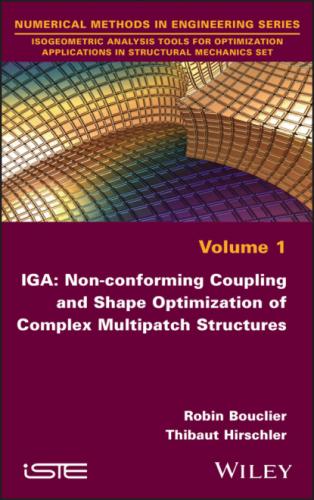[1.35b]
[1.35c]
[1.35d]
Figure 1.22. Reference domain coupling problem. For a color version of this figure, see www.iste.co.uk/bouclier/IGA.zip
In the above equations, ε (um) denotes the infinitesimal strain tensors, σm denotes the Cauchy stress tensors, Cm denotes the Hooke tensors and nm represents the outward unit normal to Ωm. We specify here that we perform, as follows, the notations in the document: continuous quantities are in normal type, while discrete quantities (i.e. vectors and matrices) are in boldface type (see equation [1.33]). To complete the formulation of the boundary value problem, the interface condition has to be added:
It ensures the kinematic compatibility and equilibrium of the tractions, respectively, along the coupling interface Γ between the two sub-domains. Combining conditions [1.36] with local equations [1.35] is strictly equivalent to a linear elasticity problem posed over the whole initial domain Ω. In the case of arbitrary non-matching and non-conforming interfaces, the coupling conditions cannot be imposed in a strong way. Instead, those coupling conditions are prescribed in the weak sense, and thus, the coupling methods differ by the way those weak conditions are formulated.
1.5.2. Penalty coupling
Let us start by defining the functional spaces
[1.37]
To account for the coupling in the penalty approach, the interface Dirichlet condition [1.36a] is weighted with its test counterpart, multiplied with a penalty parameter αpen and added to the standard virtual work formulation of the uncoupled problem. In this way, we obtain the following variational formulation for the penalty coupling: find (u1, u2) ∈ 1 × 2, such that:
where the standard bilinear form am and the linear form lm associated with domain Ωm (m ∈ {1, 2}) can be written as:
[1.39]
and
In the above equations, we note that we use the notations ・ and : to refer to the scalar product of vector fields and of second-order tensor fields, respectively.
It is important to note that the accuracy of the method strongly depends on the choice of the penalty parameter. Indeed, a large value for αpen is necessary to enforce the kinematic compatibility [1.36a]; however, making it too large makes the discrete coupled system ill-conditioned. A related drawback with this basic penalty method is that it is variationally inconsistent, in the sense that we cannot recover the interface conditions [1.36] of the strong form by using the weak form [1.38], especially the equilibrium of the tractions [1.36b]. Finally, it has to be noted that the stiffness operators of the sub-domains are merged together, which may complicate the separation of the computational resources between the different sub-domains. For all of these reasons, we will not consider this method in this book. Nevertheless, given its simplicity, we quote that the penalty approach remains of interest in IGA. Some efforts are currently performed to enhance such penalty techniques for isogeometric non-conforming coupling, in particular, with respect to the choice of the penalty parameter (see, for example, Herrema et al. (2019) and Coradello et al. (2020)).
1.5.3. Mortar coupling
A second option to weakly formulate the coupling problem [1.35]-[1.36] is to resort to the class of Lagrange multiplier methods. We note that the Lagrange multiplier approach is also often referred to as the Mortar approach in literature (Wohlmuth 2000; Brivadis et al. 2015; Dornisch et al. 2015; Zou et al. 2018; Wunderlich et al. 2019). We will use the two terminologies indifferently in the whole document. In this context, a mixed formulation is set up to impose the coupling constraints [1.36]. Classically, a single Lagrange multiplier λ ∈ (where
